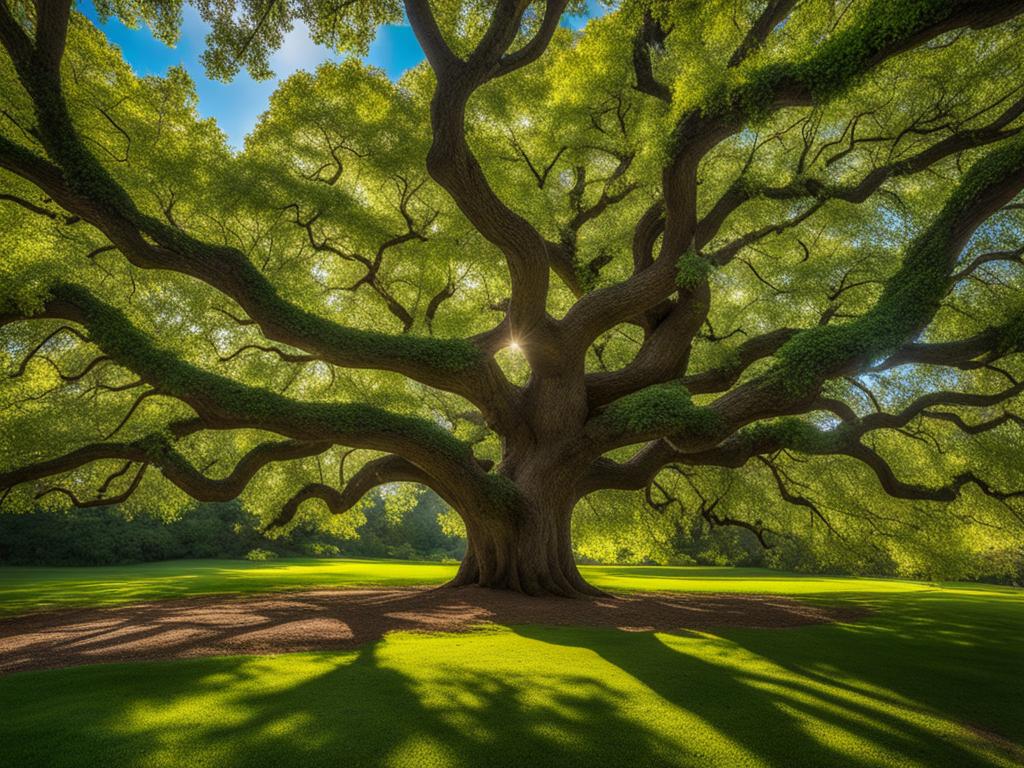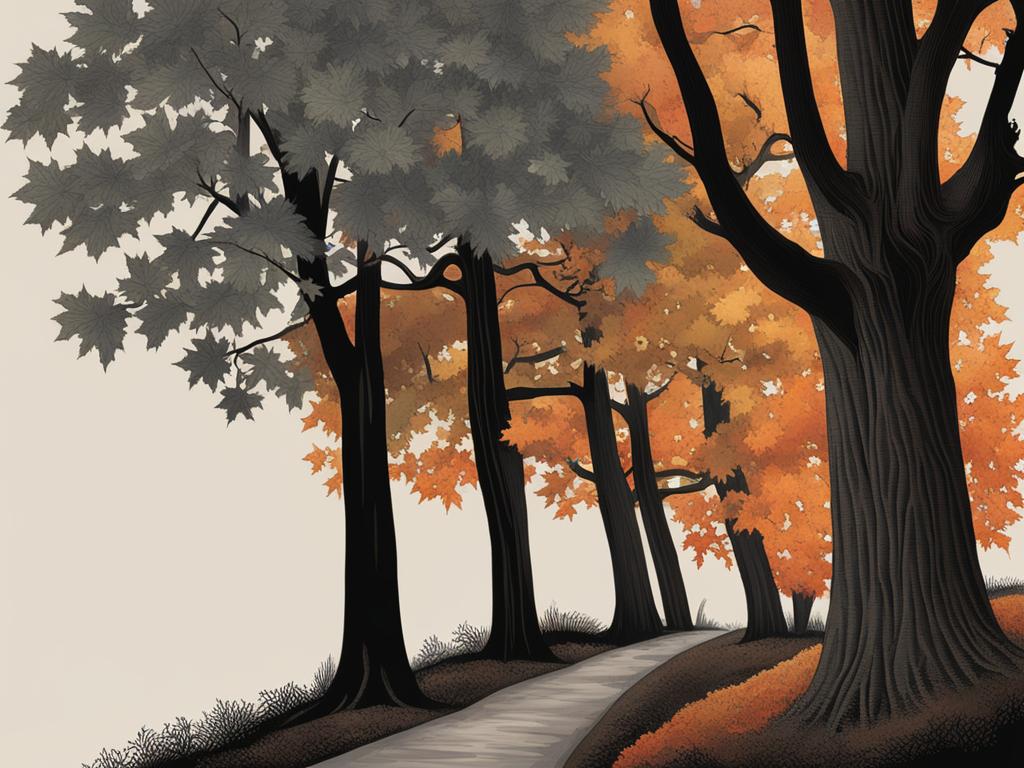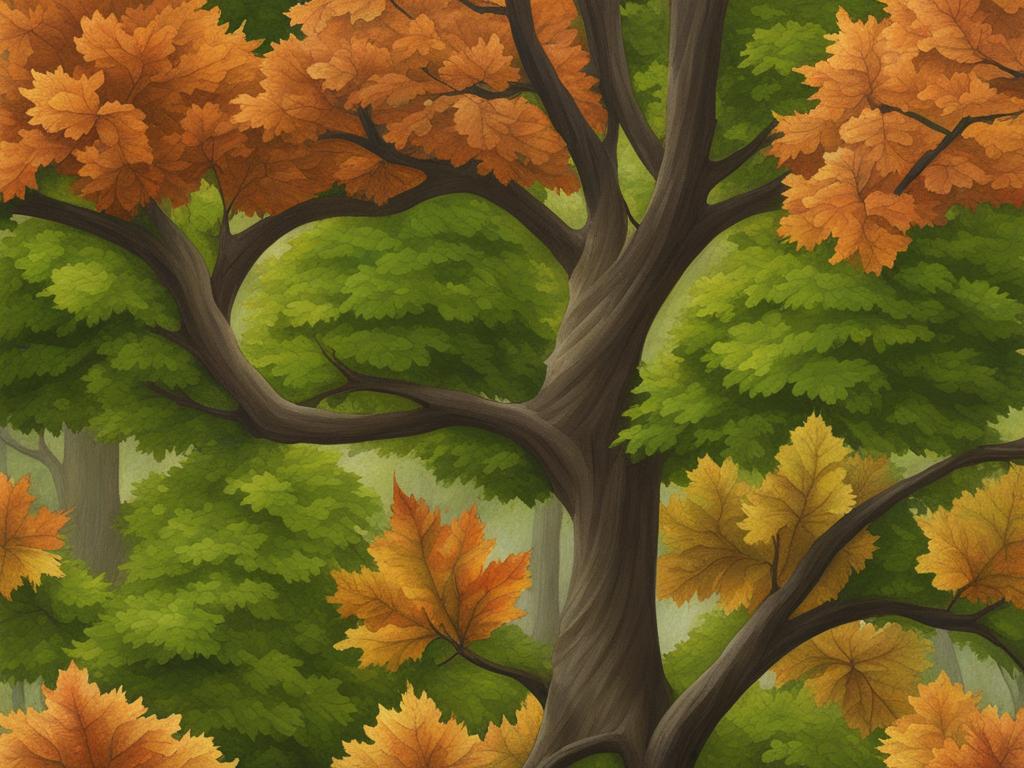When it comes to choosing the right tree for your yard, the decision can be overwhelming. Two popular choices are maple and oak trees. Understanding the differences between these tree species can help you make an informed decision that suits your outdoor space. Let’s explore the characteristics and features of maple and oak trees to determine which one is the best fit for your yard.
Key Takeaways:
- Maple and oak trees have distinct characteristics and features that make them unique.
- Maple trees are known for their stunning fall foliage and the production of maple syrup.
- Oak trees are prized for their strength, durability, and shade.
- The differences between maple and oak trees include wood hardness, leaf shapes, and bark textures.
- Consider factors such as tree characteristics, uses, and benefits when choosing between maple and oak trees for your yard.
What are Oak Trees?
Oak trees are a type of hardwood tree known for their strength and durability. They are revered for their majestic presence and ability to withstand the test of time. Oak trees can live for centuries, making them an enduring symbol of resilience in nature.
One of the most remarkable features of oak trees is their wood, which is highly valued for its strength and beauty. Oak wood is often used in construction and furniture-making due to its durability and attractive grain patterns.
Oak trees are also known for their versatility, as they can thrive in a variety of soil types and climates. Whether you have sandy soil or heavy clay, oak trees can adapt and flourish. They can tolerate both drought conditions and wetter areas, making them a reliable choice for different environments.
There are numerous types of oak trees, each possessing its own unique characteristics. Some of the most common oak tree species include:
- Northern Red Oak (Quercus rubra)
- White Oak (Quercus alba)
- Pin Oak (Quercus palustris)
- Scarlet Oak (Quercus coccinea)
- Bur Oak (Quercus macrocarpa)
Each oak species has distinct features such as leaf shape, bark texture, and acorn production. Some oak trees exhibit a broad spreading crown, while others have a more upright growth habit. Understanding the different types of oak trees can help you choose the one that aligns with your desired aesthetic and functional requirements.

The image depicts the grandeur and strength of an oak tree, showcasing its sturdy branches and lush foliage.
When considering growing conditions for oak trees, it’s important to note that they prefer full sun exposure for optimal growth. However, some oak species can tolerate partial shade. They thrive in well-drained soil and have moderate water requirements once established.
In conclusion, oak trees are renowned for their durability, versatility, and timeless beauty. The wide variety of oak tree species ensures that there is a perfect oak tree for every landscape. Whether you’re looking for a shade tree, an ornamental specimen, or a majestic centerpiece, oak trees are an excellent choice.
What are Maple Trees?
Maple trees are renowned for their distinct characteristics and various uses. These trees are particularly famous for their breathtaking fall foliage, adding vibrant colors to landscapes. With leaves featuring three to nine lobes and pronounced veins, maple trees stand out with their unique and eye-catching appearance.
Maple trees come in a variety of types, each offering its own set of features and advantages. Whether you are looking to enhance your yard’s privacy with a screening tree or add visual appeal with an ornamental tree, maple trees can fulfill these roles and more. Their versatility also allows them to be used as lovely patio trees, providing shade and creating a peaceful outdoor environment.
Types of Maple Trees
Maple trees encompass several popular species, each possessing distinct characteristics. Some of the common types of maple trees include:
| Type | Appearance | Size | Preferred Growing Conditions |
|---|---|---|---|
| Sugar Maple (Acer saccharum) | Dark green leaves with five lobes; brilliant orange-red fall foliage | Up to 100 feet tall with a spread of 40 feet | Full sun to partial shade; well-drained soil |
| Red Maple (Acer rubrum) | Green leaves with distinctive red hue in autumn | Up to 60 feet tall with a spread of 40 feet | Full sun to partial shade; adaptable to various soil types |
| Japanese Maple (Acer palmatum) | Delicate, deeply lobed leaves in a range of colors | Varies based on cultivar; generally small to medium-sized | Partial shade; moist, well-drained soil |
Maple Tree Sap and Uses
One of the most fascinating features of maple trees is their sap production. In early spring, as the temperatures gradually rise, maple trees start producing sap, which is collected for making maple syrup. The sap is extracted by tapping the trees and then boiled down to create the delicious syrup enjoyed by many.
Besides maple syrup production, maple trees offer various other uses. Their wood is highly valued for furniture, cabinetry, and flooring due to its durability and attractive grain patterns. Additionally, maple trees are excellent shade providers in outdoor spaces, shielding you from the sun during hot summer days.
“Maple trees beautifully transform landscapes during the fall season, and their sap is a source of the beloved maple syrup.”
Understanding the characteristics and uses of maple trees can help you determine if they are the ideal choice for your yard. Whether you are drawn to their stunning fall foliage, desire a versatile tree for different purposes, or simply want to try your hand at making maple syrup, maple trees can bring natural beauty and versatility to your outdoor space.
Differences Between Oaks and Maples
When deciding between maple and oak trees for your yard, it’s essential to consider the key differences between these two species. Understanding these distinctions will help you make an informed choice that aligns with your preferences and landscape needs.
Hardness:
One noticeable distinction between maple and oak trees lies in their hardness. Maple bark is known to be comparatively harder than oak bark. This characteristic makes maple trees a popular choice for furniture and flooring, as their wood is more resistant to wear and tear.
Size:
Maple trees exhibit a wider range of sizes compared to oak trees. Oak trees are generally taller, with some species growing up to 100 feet or more, while maple trees vary in height and can range from small ornamental varieties to towering specimens.
Leaves:
When it comes to foliage, maple and oak trees have distinct leaf shapes and characteristics. Oak leaves typically have rounded or pointed tips, while maple leaves feature three to nine lobes. This distinct leaf structure is one of the defining features of maple trees and adds to their overall aesthetic appeal, especially during the vibrant colors of the fall season.
Bark:
The bark texture and shade also differentiate maple and oak trees. Oak trees usually have rough and furrowed bark, providing a rugged and textured appearance. In contrast, maple trees exhibit a smoother bark texture, which can vary depending on the specific species.
By understanding the differences in hardness, size, leaves, and bark between maple and oak trees, you can make a more informed choice that suits your aesthetic preferences, landscaping requirements, and desired uses for the trees in your yard.

Oak Tree Benefits and Maple Tree Uses
When it comes to choosing between oak trees and maple trees for your yard, it’s important to consider the benefits and uses of each. Oak trees offer a range of advantages, while maple trees have their own unique characteristics and applications. By understanding the benefits of oak trees and the uses of maple trees, you can make an informed decision that suits your needs and preferences.
Benefits of Oak Trees
Oak trees provide several benefits that make them a popular choice for many homeowners:
- Shade: Oak trees are known for their wide, spreading canopies that create ample shade. This makes them ideal for creating a cool and comfortable outdoor space for relaxation and entertainment.
- Wildlife Habitat: Oak trees support a diverse range of wildlife species. Their branches and foliage provide shelter and nesting sites for birds, while the acorns serve as an important food source for birds, squirrels, and other small mammals.
- Durability: Oak wood is highly valued for its strength and durability. It is commonly used in the construction of furniture, flooring, and cabinets, as well as in outdoor applications such as decks and fences.
- Tolerant of Different Conditions: Oak trees are adaptable and can thrive in a variety of soil types, including clay, loam, and sandy soils. They are also tolerant of different climate conditions, making them suitable for various regions.
Uses of Maple Trees
Maple trees offer a range of uses that make them a versatile addition to any landscape:
- Stunning Fall Foliage: One of the highlights of maple trees is their vibrant fall foliage. The leaves transform into shades of red, orange, and gold, creating a breathtaking display of colors that adds beauty and visual interest to your yard.
- Maple Syrup Production: Maple trees are well-known for their sap, which can be tapped and used to produce maple syrup. This natural sweetener is loved by many and can be enjoyed on pancakes, waffles, and other desserts.
- Screening and Privacy: The dense foliage of maple trees makes them an excellent choice for creating privacy screens or reducing noise pollution. They can be strategically planted along property boundaries or near outdoor living areas to enhance privacy.
- Ornamental Purposes: With their attractive appearance and striking foliage, maple trees are often used as ornamental trees in landscaping designs. They can be planted as focal points or used to enhance the visual appeal of gardens and landscapes.
By understanding the benefits of oak trees and the uses of maple trees, you can decide which tree is the best fit for your yard. Whether you’re looking for shade, wildlife habitat, durability, or stunning fall foliage, both oak trees and maple trees can offer unique advantages and enhance the beauty of your outdoor space.
| Oak Tree Benefits | Maple Tree Uses |
|---|---|
| Provides shade | Displays stunning fall foliage |
| Serves as wildlife habitat | Produces maple syrup |
| Offers durable wood for various applications | Can be used for screening and privacy |
| Tolerant of different soil and climate conditions | Used as ornamental trees for landscaping |
Conclusion
When it comes to selecting the perfect tree for your yard, there are a few important factors to consider. Both maple and oak trees have their own unique characteristics, uses, and benefits that make them desirable options. Maple trees are known for their spectacular fall foliage and the production of maple syrup, while oak trees offer strength, durability, and ample shade.
To make the best decision, it’s crucial to assess your personal preferences and the specific needs of your outdoor space. If you value vibrant colors and enjoy the idea of making your own maple syrup, a maple tree might be the right choice for you. On the other hand, if you prioritize shade and strength, an oak tree could better meet your requirements.
Additionally, consider the size, soil conditions, and climate in your area when choosing between maple and oak trees. Maple trees have a wider range of sizes, while oak trees can withstand various soil and climate conditions. Take into account the potential long-term growth of the tree and how it will fit into your landscape design.
In conclusion, whether you opt for a maple or oak tree, both varieties can enhance the beauty and functionality of your yard. By carefully considering the factors mentioned above, you can choose the right tree that aligns with your preferences and creates an inviting, natural environment in your outdoor space.
FAQ
What are the differences between oak and maple trees?
Oak trees are known for their strength and durability, while maple trees are prized for their stunning fall foliage and the production of maple syrup.
What are the characteristics of oak trees?
Oak trees are hardwood trees known for their strength and durability. They can live for centuries and their wood is highly valued for its strength and beauty.
What are the characteristics of maple trees?
Maple trees are known for their striking fall foliage and the production of maple syrup. They have leaves with three to nine lobes and pronounced veins.
How do oak and maple trees differ in size?
Maple trees have a wider variety of sizes compared to oak trees.
What are the differences in leaves between maple and oak trees?
Oak leaves have rounded or pointed tips, while maple leaves have three to nine lobes.
What are the benefits of oak trees?
Oak trees provide shade, wildlife habitat, and can withstand different soil and climate conditions. They are also highly valued for their wood.
What are the uses of maple trees?
Maple trees can be used for screening, ornamental purposes, and even as patio trees. They are also known for producing sap, which is used to make maple syrup.
How do maple and oak trees differ in bark texture?
Maple and oak trees have different bark textures.
Should I choose a maple or oak tree for my yard?
The choice between maple and oak trees depends on your personal preferences and the specific needs of your outdoor space.
